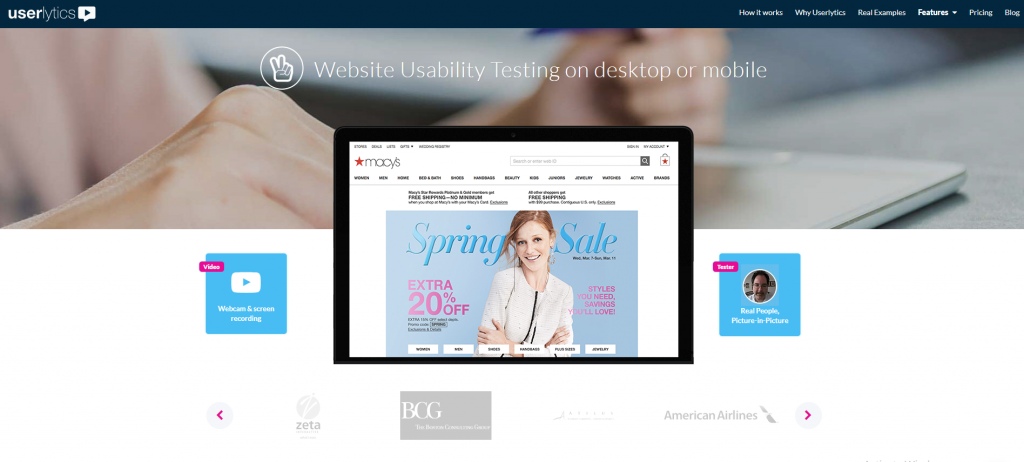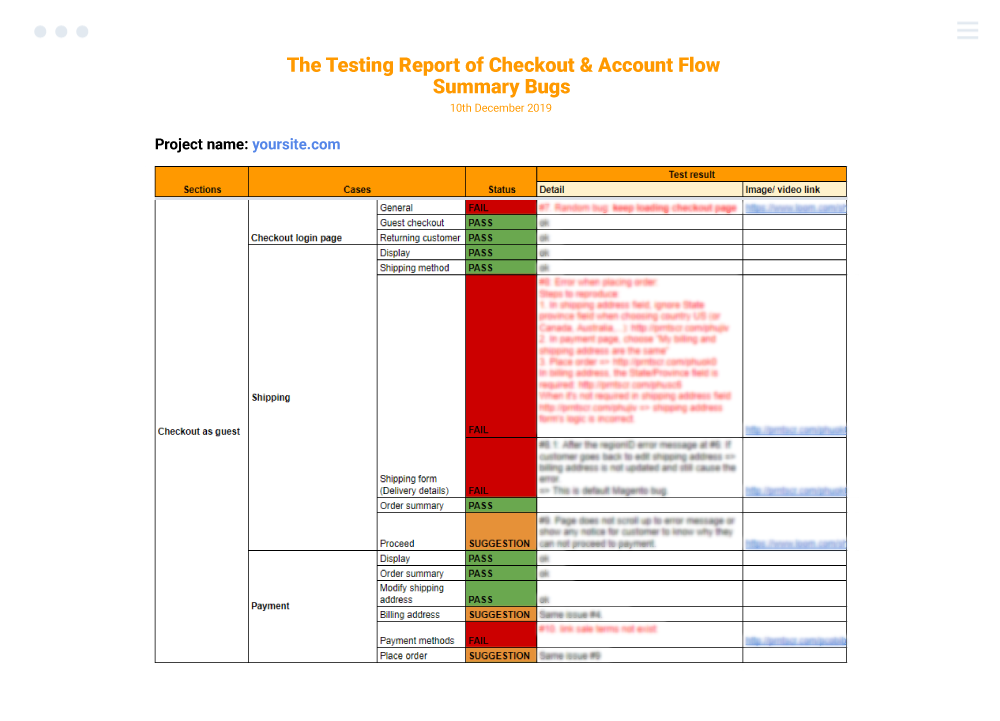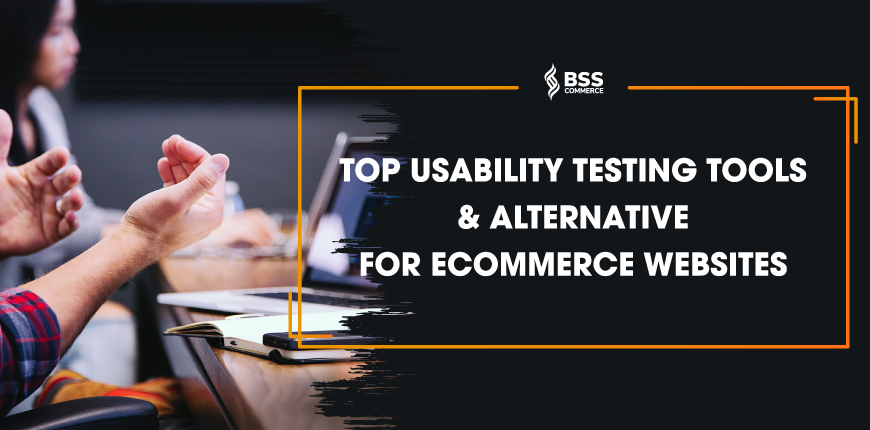As mentioned in the previous post about types of Magento Testing, Usability Testing involves measuring how usable or intuitive a website or application is and how easy it is for users to achieve their objectives. The test’s goal is to uncover areas of confusion to enhance the overall user experience.
Magento website is just one case that needs to be tested in terms of usability. This type of testing is also necessary for every ecommerce website or application to make sure customers have a happy online shopping experience.
Website usability testing tools can be described as solutions to evaluate websites’ usability in a host of criteria and then return feedback and reviews for digital user experience. Most usability testing tools for websites in this post offer functions that allow online businesses to recruit testers or participants. They are then required to perform created tasks and share their experience with digital assets.
Let’s go into details with the top 5 most popular usability testing tools for websites. To be more helpful, we also include the top pros and cons collected from users of each one for easy evaluation.
5+ Commonly-Used Usability Testing Tools for Websites with Pros & Cons
Table of Contents
1. UserTesting

UserTesting enables every firm to offer the best digital experience driven by customers’ insights. Using this on-demand human insights platform, businesses across industries can make smart experience-driven decisions at every level, at the speed business demands.
When you use UserTesting for usability testing, it’s easy to discover how target users interact with your design and describe where they get stuck or confused.
# Here are highlighted features that UserTesting offers:
- Support video, audio, and written feedback from your target market
- Send back usability testing reports in hours, not days
- Test on any device, from desktop, iPhone, iPad, Android phones, to Android tablets
- Run your own tests or use our professional services
- Test with users in their natural environment, not a usability lab
# Pros:
- Support live 1-1 conversations with the target market (remote interview)
- Simple user interface
- Fast turnaround for results
# Cons:
- There’s no way to manage permission within a test team
# Website: https://www.usertesting.com/
2. Userfeel (Website usability testing example included)

Userfeel is another usability testing tool for websites that report videos of real users speaking their feedback as they navigate your website or application. It was designed and developed for usability researchers, newcomers to UX research and anyone who wants to optimize their website or app.
# Key features of Userfeel:
- Test any website in any language (multilingual usability & user testing tool)
- Test on any device
- Organize tests neatly into projects and add as many team members as you need
- Return results under video capturing the most critical issues
- Filter testers using various demographics like age, gender, country, language, etc.
- Use screener questions to filter the testing panel for more details
- Support automatic voice transcription for all languages
# Pros:
- Easy to use with a user-friendly interface
- Support various features to pick appropriate testers
# Cons:
- There are very few cons shared by users
Visit Userfeel website to watch website usability testing examples, including unmoderated and moderated usability testing in 40 languages across devices.
3. UserZoom
UserZoom is a UX insight solution that automates UX research for scale and speed. It finally reports valuable UX insights to improve the digital experience on websites and impact the bottom line.
This website usability testing tool is a combination of software, services and participant sourcing solutions. It allows businesses to test, benchmark and evaluate the UX of any website at any development phase and on any device, and get the actual story behind their user experience.
Using UserZoom for usability testing, you can get fast and actionable insights with video, screen capture and audio of real users who share their feedback for experience on your website.
Furthermore, you can also highlight UX as your competitive advantage with usability benchmarking feature to measure your competitors’ performance.
# Pros:
- Offer a wide variety of testing, from tree testing, card-sorting (in addition to usability testing)
# Cons:
- The user interface looks a bit old-fashioned and not very intuitive
# Website: https://www.userzoom.com/
4. Userlytics (Website usability test example included)

Userlytics is a state of the art usability testing tools that enables you to run user experience tests on any digital asset device.
In the beginning, you need to define your test goals, target persona, and even custom screener questions if necessary. You can also select the device where you want your asset to be tested. The advanced test creation process and the proprietary panel of Userlytics allow the tests to be set up in minutes. Afterward, custom analysis and reports can be completed in just hours.
Especially, Userlytics is one of the user testing platforms that record the webcam, audio, and screen of the participants’ device while also supporting an infinite number of annotations, highlight reels, users/admins, participants per session and number of concurrent studies.
For a website usability test example from Userlytics, please watch this sample video in which they work on Airbnb’s website.
# Pros:
- Support card-sorting and tree testing (in addition to usability testing)
# Cons:
- When recruiting mobile users, you can only choose Android or iPhone, you cannot select both
# Website: https://www.userlytics.com/
5. Loop11

Loop11 supports online usability testing feature that allows running unmoderated remote usability testing utilizing with users performing real tasks. The tool allows you to use its panel of verified user experience participants or bring your own participants.
You can create tasks for participants to perform and ask survey questions (including multiple-choice, single response, rating, and ranking scale questions. The data is then returned under a report that contains the task completion rate, common fail pages, time on task, paths, and comprehensive path analysis for every user.
# Key features of Loop11:
- Support testing on desktop, mobile, and table
- Video, audio, and screen recordings
- Comprehensive testing analytics
- Included metrics: task completion rate, heatmaps, clickstream analysis, time on task, System Usability Scale, and so on
# Pros:
- Unlimited number of participants
# Cons:
- Sometimes it’s a bit hard to navigate the tool and the user interface can be improved
Get Tips to Use Website Usability Testing Tools Effectively
We want to address a fact: No tool naturally comes in handy. Usability testing tools for websites are not an exception. Therefore, don’t skip these tips before you use any tool.
Choose a web usability testing tool that meets your requirements
An appropriate usability testing tool lays the foundation for your successful tests. Accordingly, make sure you use a tool that can satisfy a host of your requirements.
For example, you’ll most likely need a tool that:
- Captures participants faces, audio and screen in a picture-in-picture format
- Collects quantitative data, for example, time on task, success/failure rates, and system usability scale (SUS)
- Allows you to recruit testers with standard and custom demographic criteria
- Allows you to create annotate and share important events and comments
- Enable questions to be delivered at any phase of the test script Specify clear objectives and stick to them
Whether you’re testing a single feature or an entire app or website, well-defined objectives are the key to successful tests with website usability testing tools. Without clear objectives, final results will be mostly useless and you’ll be left with handfuls of pointless data.
Our tip for setting clear objectives is to divide your testing goals into categories and determine what kind of data is necessary. For instance, for satisfaction metrics, you’ll need qualitative data; for adoption/acceptance goals, metrics will be empirical and time-dependent.
Test with your target users
Choosing the correct user (testers who join your tests) demographic is perhaps the most critical condition of successful usability testing.
In many cases, random users may return very different feedbacks in comparison with target users. For this reason, it’s critical to test on users who represent the majority of your target customers based on key demographic criteria like age, income, location, language, or level of web experience.
Ask for details in feedback
There are many usability testing tools for websites that allow you to create as many questions and tasks as you like to get the insights you need. The more details you ask, the more insights and problems you will uncover.
Or even, you should also ask for additional or unusual feedback that you think may be useful in the final analysis.
Drawbacks of Web Usability Testing Tools & Alternatives
Drawbacks
Though the mentioned tools are commonly used for user testing in general and usability testing in particular, they feature remarkable drawbacks.
First, the test’s results depend so much on how the way you set testing tasks and how detailed you request users to check. For that reason, there may be a case where you miss “this” or “that.”
Second, it’s hard to make sure participants test your website seriously because it’s a kind of remote tasks conducted by users with various levels of expertise. If you do not choose users wisely, it’s difficult to know if the tests are in-depth.
A Cost-efficient alternative solution for ecommerce websites
Ecommerce Website Testing On-Demand service is a more cost-efficient alternative for web owners. Why is that so?
- Experienced experts in ecommerce usability/functionality testing
- In-depth evaluation
- Intensive reports and feedbacks
- Short time to deliver the results
Ecommerce Website Testing On-Demand is offered for both ecommerce websites or mobile apps from one to several storeviews. Here comes an example of a testing report for an ecommerce website.

(CONTACT NOW to for a free consultation with our experts)
Bottom Lines
Web usability testing tool, in general, is one of the available methods for UX research that online businesses need to accelerate conversions. Besides this method, am in-depth web testing service is another option for those who target a flawless website that customers will love.
BSS Commerce is one of the leading Magento extension providers and web development services globally. With experienced and certified Magento developers, we commit to bringing high-quality products and services to optimize your business effectively. Furthermore, we offer FREE Installation – FREE 1-year Support and FREE Lifetime Update for every Magento extension.
CONTACT NOW to let us know your problems. We are willing to support you every time.
